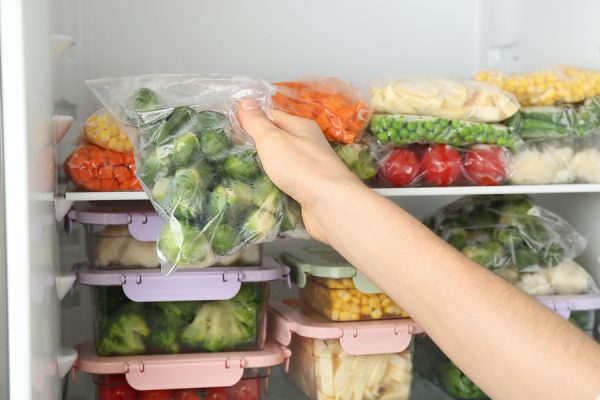Blanching is the process of boiling or steaming vegetables for a short period of time in order to stop the “aging” process of vegetables. [1] This method of quickly cooking vegetables inactivates the enzymes that break vegetables down over time.
Blanching comes in handy when you have an abundance of fresh vegetables. Maybe your garden produced more green beans than you were expecting or zucchini was on super sale at the grocery store. Whatever the reason, blanching is your path to locking in flavor and saving those veggies for a rainy day.
Some vegetables, like diced onions and peppers, can be frozen raw and do not require blanching. However, blanching is necessary before freezing most vegetables in order to preserve vegetable flavor, color, texture, and nutrients. Fruits are usually served raw and therefore do not need to be blanched like vegetables before being frozen. [2]
How to blanch vegetables
To blanch your vegetables, you’ll need to grab:
- A large pot
- A strainer
- A large bowl for ice water
- Optional: a blancher, which includes a blanching basket to fit inside the pot
Here’s how to blanch your vegetables via boiling or using a blancher. Click here to learn how to steam blanch.
- You must first prepare your vegetables for how you’d like to eventually cook with them. Here are the different ways certain vegetables are recommended to be peeled, trimmed, or cut before blanching.
- Grab your large pot and fill it with water. You will want one gallon of water per pound of prepared vegetables. So if you are trying to blanch two pounds of zucchini, you will need to add two pounds of water to the pot. Only blanch one type of vegetable at a time, because each vegetable has a different blanching time (you will learn more in step 5).
- Bring the water to a vigorous boil. While your water is heating up, prepare a large bowl of ice water. Grab your bowl and fill it with water and a lot of ice.
- Once the water in your pot is boiling, place your vegetables into the water or into the basket if you are using a blancher. The water should return to boil in one minute. If it doesn’t, there is not enough water in the pot for the amount of vegetables you are trying to blanch.
- As soon as the pot begins to boil again, the blanching time begins. The amount of time vegetables are blanched for is very important. Different vegetables require different blanching times. The National Center for Home Food Preservation explains that under-blanching stimulates the activity of enzymes and is worse than no blanching. Over-blanching causes loss of flavor, color, vitamins and minerals. Follow recommended blanching times found here. For example, broccoli florets have a blanching time of 3 minutes. That means broccoli florets should stay in the water for 3 minutes after the pot returns to a boil.
- Once the blanching time for your specific vegetable is over, you will want to quickly get the vegetable out of the boiling water to stop the cooking process. Place your strainer in the sink and pour the entire contents of the pot into the strainer. If you’re using a blancher, simply remove the basket from the water.
- Immediately turn to your bowl of ice water. Pour the strained vegetable into the bowl of water. This step quickly stops the cooking process. Another option is to keep the vegetable in the strainer and run very cold water over the vegetables. Cooling vegetables should take the same amount of time as blanching. For example, the broccoli florets from before will need to be in the bowl of ice or remain under cold running water for 3 minutes.
- Your vegetables are now blanched! Drain them thoroughly and lay them on a clean towel. Pat them dry to remove extra moisture.
- Pack your blanched vegetables in food safe, plastic freezer bags or rigid containers before storing in the freezer. Some vegetables may expand when frozen so leave a little extra space in the container before sealing. Label and date the container and put it in the freezer.

Now you’ve got a frozen vegetable on hand that you can cook when you need a quick meal in the future. Cook blanched vegetables as you would normal frozen vegetables within 1 year of blanching. [3]
Written by Taylor Newman, Ph.D. Candidate | Edited by Laurel Sanville, MS, RDN, LD
[1] National Center for Home Food Preservation